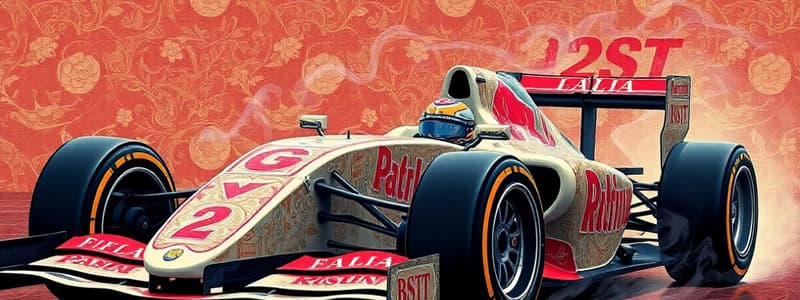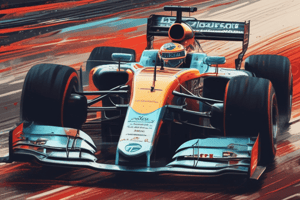Podcast
Questions and Answers
What is the primary focus of F1 cars in terms of design and technology?
What is the primary focus of F1 cars in terms of design and technology?
- Energy conservation
- Maximum speed and efficiency (correct)
- Compact size
- Aesthetic appeal
Which component of an F1 car is responsible for generating the power needed for high-speed performance?
Which component of an F1 car is responsible for generating the power needed for high-speed performance?
- Chassis
- Engine (correct)
- Tires
- Aerodynamic design
What is the role of aerodynamics in F1 car design?
What is the role of aerodynamics in F1 car design?
- Improving visual aesthetics
- Increasing engine power
- Reducing weight and size
- Maintaining efficient performance (correct)
What kind of teams compete in F1 racing?
What kind of teams compete in F1 racing?
Which governing body is responsible for enforcing safety regulations in Formula 1?
Which governing body is responsible for enforcing safety regulations in Formula 1?
What must changes to car design or technology adhere to?
What must changes to car design or technology adhere to?
How do different track conditions affect F1 races?
How do different track conditions affect F1 races?
What aspects does F1's popularity incorporate beyond sports?
What aspects does F1's popularity incorporate beyond sports?
What is one of the unique challenges presented by different F1 tracks?
What is one of the unique challenges presented by different F1 tracks?
What role does media play in F1?
What role does media play in F1?
Flashcards
What is Formula 1?
What is Formula 1?
A motorsport competition involving open-wheeled single-seater racing cars, considered the highest class of single-seater auto racing.
What are some defining characteristics of F1 cars?
What are some defining characteristics of F1 cars?
F1 cars utilize specialized components for extreme performance, including powerful engines, lightweight designs, and advanced aerodynamics.
What is the role of the engine in an F1 car?
What is the role of the engine in an F1 car?
The internal combustion engine (ICE) is a crucial component, generating significant power needed for consistent high-speed performance.
What are the main championships in Formula 1?
What are the main championships in Formula 1?
Signup and view all the flashcards
What is the role of regulations in F1?
What is the role of regulations in F1?
Signup and view all the flashcards
F1 Regulations
F1 Regulations
Signup and view all the flashcards
F1 Track Variations
F1 Track Variations
Signup and view all the flashcards
F1 Weather Impact
F1 Weather Impact
Signup and view all the flashcards
Environment's Role in F1
Environment's Role in F1
Signup and view all the flashcards
F1's Global Impact
F1's Global Impact
Signup and view all the flashcards
Study Notes
Formula 1 (F1) Overview
- F1 is a motorsport competition for open-wheeled single-seater racing cars.
- It's considered the highest class of single-seater auto racing.
- The cars are highly technologically advanced, pushing the boundaries of design and engineering.
- Drivers compete in a series of races held across the world.
- The sport attracts a global audience.
Defining Characteristics of F1
- High Performance and Speed: F1 cars are designed for maximum speed and efficiency. This is evident in the highly specialized nature of the vehicles' components.
- Specialized Components: F1 cars utilize specialized components for extreme performance, including powerful engines, lightweight designs, and advanced aerodynamics.
- Precise Control Systems: Cars include sophisticated systems for control and handling, contributing to the complex driving environment within races.
Key Components of F1 Cars
- Engine: The internal combustion engine (ICE) is a crucial component, generating significant power needed for consistent high-speed performance.
- Chassis: The chassis, or the main structure of the car, supports all the components in the racing car. It's engineered for exceptional impact resistance and robustness, while also maintaining a low center of gravity for responsiveness.
- Aerodynamic Design: Aerodynamics plays an enormous role in maintaining efficient performance. Significant engineering and calculated design is involved in streamlining the car to be incredibly fast.
- Tires: Tires are critically important for maintaining traction and handling during high-speed races. They are engineered to give excellent grip on different types of racing tracks.
- Safety Features: F1 cars are well-equipped with safety features such as advanced safety cell designs, strong materials, and robust safety systems to minimize injuries during accidents.
F1 Teams and Competition
- Teams compete for championships, including the driver's championship and the constructor's championship.
- Teams represent different nations and vary in their historical success.
- Teams employ expert engineers, technicians and strategists.
- Teams have substantial budgets to maintain competitive advantage.
F1 Regulations and Safety Standards
- Regulations regarding safety and performance are strict and are constantly being reviewed and modified.
- International governing bodies, such as the FIA, enforce high safety standards.
- Changes to car design or technology must meet stipulated standards of compliance.
- There are regulations on car design, the performance of equipment, and the behaviour of teams and drivers.
F1 Track Environments
- F1 races occur on various tracks worldwide, each with its own unique challenges and demands on drivers and cars.
- Tracks vary greatly in terms of length, layout, and surface conditions.
- Different track conditions (such as weather) present a further layer of variability to the race.
- The environment significantly affects the strategy and performance of drivers.
F1's Cultural and Media Impact
- F1 is a global sport, attracting a large international audience.
- The sport has significant media attention and publicity.
- Media reporting and coverage of F1 events are widespread.
- F1's popularity extends beyond sporting circles, incorporating aspects of technology, entertainment, and global recognition.
Studying That Suits You
Use AI to generate personalized quizzes and flashcards to suit your learning preferences.




